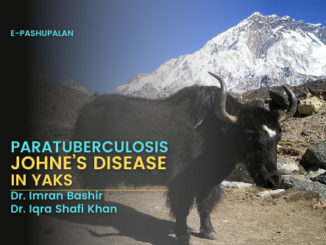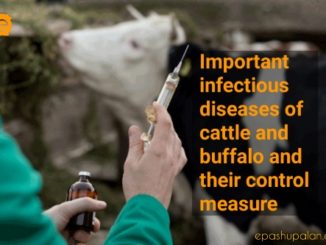Abstract
Tetanus also called as lock jaw condition with worldwide distribution is characterized by hyperesthesia, tetany and convulsions. Tetanus is known to cause high fatality in horses by production of exotoxins affecting domestic animals, wildlife, and humans. Production of tetanospasmin and tetanolysin are responsible for the pathology of tetanus.
Introduction
Tetanus is caused by Clostridium tetani, gram positive rod (0.3–0.6 μm wide and 3–12 μm long) spore forming anaerobic neurotoxic bacteria that is common soil inhabitant the spores of the tetanus can persist in soil for many years (Quinn et al 2011). C. tetani spores are round and terminal, giving typical shape as “tennis racket” (0.7 μm × 0.5 μm). The portal of entry is mainly through the deep puncture wound. In horses puncture wounds of the hooves are the common sites of entry and in neonatal equids the umbilicus remains as the main source of entry. Horses are reportedly as the most susceptible domestic species to the effects of tetanus toxin (Constable et al 2016). The disease is characterized by generalized muscular rigidity and spasms, hyperesthesia, convulsions, respiratory arrest, and death. The incubation period varies between 3 days and 4 weeks with occasional cases as long as several months after the infection appears. Tetanus bacteria localizes at the site of the introduction and release the tetanospasmin and tetanolysin. Tetanolysin aids in the local tissue necrosis while as tetanospasmin disseminates into the systemic circulation where it impedes the spontaneous and nerve impulse evoked release of neurotransmitter, which results in the disinhibtion of gamma motor neurons. The diagnosis of equine tetanus is based on typical clinical signs, presence of wounds or history of surgical procedures that may predispose to disease (Mackay 2014).
Clinical Signs of tetanus
The tetanus has different forms in horses acute and subacute and clinically as localized and generalized form. In the acute form, spastic paralysis rapidly spreads from the head (muscles of mastication, ears, third eyelid) to the respiratory muscles and then to the limbs. Generalized convulsions are accompanied by sweating. Death can occur in 1–2 d because of respiratory failure. In the subacute forms, signs develop in 1–3 wk. Some animals may recover. Hyperesthesia and prolapse of the third eyelid are common early signs. Eating and swallowing are difficult because of paralysis of the mastication muscles. Localized tetanus is rare and may precede generalized tetanus. It causes painful spasm of muscles adjacent to the wound site. Generalized tetanus has a difficult course and involves a large number of symptoms. The main clinical signs include, erect ears, flare nostrils, sneering, pump handle respiration, excessive salivation, quidding, constipation, retention of urine and saw horse stance with a global feature comparable to that of a wooden horse.
Recent Studies
The recent studies conducted by few authors in perspective to tetanus have focused on the epidemiology and outcome of tetanus cases in equines. Ribeiro et al 2018 studied retrospectively 70 cases of equine tetanus and recorded high mortality rate (72.9%) with forty (57.1%) horses had been presented history of wounds or surgical procedures related with tetanus, represented mainly by lesions in the hind limbs (42.5%), front limbs (15.0%), umbilical infections (7.1%), castration (4.3%), and face wounds (4.3%). Hyperesthesia, limb spasticity, cervical stiffness, tetanic spasms, and restriction of jaw movement were the main consistent clinical signs.
Kay and Knottenbelt (2007) studied prevelance of tetanus at hospital 56 equids with a clinical diagnosis of tetanus were hospitalised and treated, and 8 equids with tetanus were subjected to euthanasia without treatment. The total number of tetanus cases represented 0.07% of the total patient load and 2% of all hospitalised patients.
Van Galen G et al (2017) in a analysis of 176 tetanus cases in horses concluded that mortality rate was 68.2%. Mortality rates in adults and foals were 68.4% and 66.7%, respectively Variables associated with survival in adults included: standing, normal intestinal sounds and defecation, voluntarily drinking, eating soft or normal food, lower heart and respiratory rates, high base excess on admission, longer diagnosis time, treatment and hospitalization delay, and mild severity grade. Variables associated with death included: anorexia, dysphagia, dyspnea, low blood potassium concentration on admission, moderate and severe disease grading, development of dysphagia, dyspnea, recumbency and seizures during hospitalization, treatment with glycerol guaiacolate, intravenous fluids, and intravenous glucose solutions. Variables associated with survival in foals included standing on admission, voluntarily eating soft food and drinking, older age, and longer hospitalization delay.
Treatment, Management and Control
The goal to the treatment of tetanus is based on five basic principles:
- Elimination of the causative agent done by the administration of parental antibiotics arrest the growth and multiplication of tetani and thus also multiplication of the neurotoxin as well as suppression of secondary infections. At the same time, the wound should be cleaned of any foreign material such as devitalised and necrotic tissue with hydrogen peroxide and local application of pencillin may facililate absorption of the toxin. The antibiotic of first option is procaine-penicillin G at a dose of 20—100,000 IU.kg administered intravenously, intramuscularly or subcutaneously every 6—12 hours. Other antibiotics, which may also be effective are: tetracycline at a dose of 22 mg.kg–1 orally every eight hours, clindamycin at a dose of 3—10 mg.kg–1 every eight to twelve hours intravenously, intramuscularly or orally, and amoxicillin-clavulanate at a dose of 12 mg.kg–1 orally or subcutaneously every twelve hour
- Neutralize Residual toxin. As the signs of tetanus of appeared the administration of antitoxin has a little value However, One hundred units of antitoxin per 1 kg of body weight are recommended (maximum dose of 20 000 IU) given by a slow, over ten minutes intravenous administration. Repeated dose of antitoxin is not recommended because of the risk of anaphylactic and anaphylactoid-type reactions.
- Control muscle Spasms Various drugs have been administered. Cholorpromazine (0.4-0.8mg/kg BW intravenously, 1.0mg/kg bw intramuscularly three to four times a daily) and acetyl promazine (0.05mg/kg BW twice daily) until severe signs subside. A combination of diazepam (0.01-0.4mg/kg) and xylazine (0.5-1.0mg/kg, intravenously or intramuscularly).
- Hydration can be maintained by intravenous or stomach tube.
- Supportive treatment patient is hypersensitive to auditory or tactile stimulus, and therefore it should be kept in a quiet, dark room ears packed with cotton with well bedded quarters with non-slippery floors. Feeding and watering devices should be high enough to allow the horse to use them without lowering the head. Slings may be useful for horses having difficulty standing or rising.
Control
Tetanus can be avoided by proper disinfection of skin and instruments while carrying any kind of castration and vaccination. Immunization is recommended annually with tetanus toxoid and is usually recommended for all horses. Mares should be vaccinated during the last 6 weeks of pregnancy and the foals vaccinated at 5 to 8 weeks of age. In high-risk areas, foals may be given tetanus antitoxin immediately after birth and every 2 to 3 weeks until they are 3 months old, at which time they can be given toxoid.
References
- Constable P.D, Hinchliff K.W., Done S. & Gruenberg W. 2016. Veterinary medicine: a textbook of the diseases of cattle, horses, sheep, pigs, and goats. 11th ed. Saunders Ltd, Philadelphia. 2,278p.
- Kay G. & Knottenbelt, D. C. (2007). Tetanus in equids: a report of 56 cases. Equine Veterinary Education, 19(2), 107-112.
- Mackay R.J. 2014. Tetanus, p.368-372. In: Sellon D.C. & Long M.T. (Eds), Equine Infectious Diseases. 2nd ed. Saunders Elsevier, St Louis, Missouri.
- Quinn PJ, Markey B.K., Leonard F.C., Fitzpatrick E.S., Fanning S. & Hartigan P.J. 2011. Clostridiumspecies, p.233-249. In: Quinn P.J., Markey B.K., Leonard F.C., Fitzpatrick E.S., Fanning S. & Hartigan P.J. [Eds], Veterinary Microbiology and Microbial Disease. 2nd ed. Wiley-Blackwell, UK.
- Ribeiro, M. G., Nardi Júnior, G. D., Megid, J., Franco, M. M., Guerra, S.T., Portilho, F. V.,Rordiguez S.A & Paes, A. C. (2018). Tetanus in horses: an overview of 70 cases. Pesquisa Veterinária Brasileira, 38(2), 285-293.
- Van Galen, G., Rijckaert, J., Mair, T., et al., 2017: Retrospective evaluation of 155 adult equids and 21 foals with tetanus from Western, Northern, and Central Europe (2000—2014). Part 2: Prognostic assessment. J. Vet. Emerg. Crit. Care (San Antonio) 27(6) 697-706.
|
The content of the articles are accurate and true to the best of the author’s knowledge. It is not meant to substitute for diagnosis, prognosis, treatment, prescription, or formal and individualized advice from a veterinary medical professional. Animals exhibiting signs and symptoms of distress should be seen by a veterinarian immediately. |







Very precise and informative article
wonder work, such a short and informative piece on Tetanus.
Really precise, good article.
Very informative article 💯
Looking forward to read more 🙏
Very Informative and helpful!!
Informative article👌
Quite informative….keep writing more👌👌